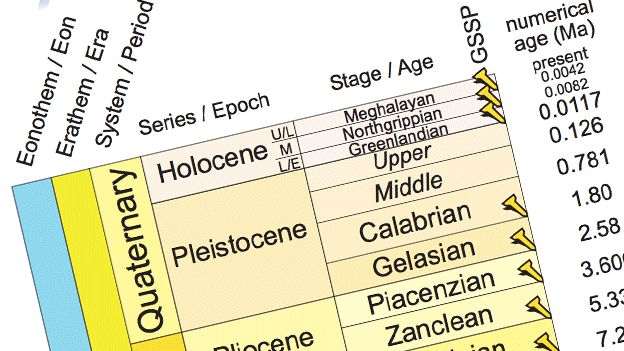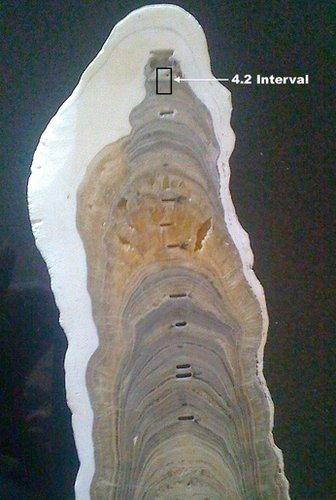Welcome to the Meghalayan Age - a new phase in history
- Published

The famous timeline will be updated to reflect the new "stages", or "ages", as they are called
The official history of Earth has a new chapter - and we are in it.
Geologists have classified the last 4,200 years as being a distinct age in the story of our planet.
They are calling it the Meghalayan Age, the onset of which was marked by a mega-drought that crushed a number of civilisations worldwide.
The International Chronostratigraphic Chart, the famous diagram depicting the timeline for Earth's history (seen on many classroom walls) will be updated.

A portion of an Indian stalagmite that defines the beginning of the Meghalayan Age
It should be said, however, there is disquiet in the scientific community at the way the change has been introduced. Some researchers feel there has been insufficient discussion on the matter since the Meghalayan was first raised as an idea in a scholarly paper, external six years ago.
Geologists divide up the 4.6-billion-year existence of Earth into slices of time.
Each slice corresponds to significant happenings - such as the break-up of continents, dramatic shifts in climate, and even the emergence of particular types of animals and plant life.
We currently live in what is called the Holocene Epoch, which reflects everything that has happened over the past 11,700 years - since a dramatic warming kicked us out of the last ice age. But the Holocene itself can be subdivided, according to the International Commission on Stratigraphy (ICS).
It is the official keeper of geologic time and it proposed three stages be introduced to denote the epoch's upper, middle and lower phases.
These all record major climate events. The Meghalayan, the youngest stage, runs from 4,200 years ago to the present. It began with a destructive drought, whose effects lasted two centuries, and severely disrupted civilisations in Egypt, Greece, Syria, Palestine, Mesopotamia, the Indus Valley, and the Yangtze River Valley.
It was likely triggered by shifts in ocean and atmospheric circulation.
The Meghalayan Age is unique among the many intervals of the geologic timescale in that its beginning coincides with a global cultural event produced by a global climatic event, says Stanley Finney, professor of geological sciences at Long Beach State University and Secretary-General of the International Union of Geological Sciences (IUGS), which ratified the ICS proposal.
The middle phase of the Holocene will be referred to as the Northgrippian, and runs from 8,300 years ago up to the start of the Meghalayan. The onset for this age was an abrupt cooling, attributed to vast volumes of freshwater from melting glaciers in Canada running into the North Atlantic and disrupting ocean currents.
The oldest phase of the Holocene - the exit from the ice age - will be known as the Greenlandian.
Allow X content?
This article contains content provided by X. We ask for your permission before anything is loaded, as they may be using cookies and other technologies. You may want to read X’s cookie policy, external and privacy policy, external before accepting. To view this content choose ‘accept and continue’.

To win a classification, a slice of geological time generally has to reflect something whose effects were global in extent, and be associated with a rock or sediment type that is clear and unambiguous.
For the famous boundary 66 million years ago that marks the switch in period from the Cretaceous to the Palaeogene, this "golden spike" is represented by traces in sediments of the element iridium. This was spread across the planet in the debris scattered by the asteroid that wiped out the dinosaurs.
For the Meghalayan, the spike is epitomised in a perturbation in the types, or isotopes, of oxygen atoms present in the layers of a stalagmite growing from the floor of Mawmluh Cave in the northeastern state of Meghalaya in India. This two-step change is a consequence of weakening monsoon conditions.
"The isotopic shift reflects a 20-30% decrease in monsoon rainfall," explained Prof Mike Walker of the University of Wales, UK, who led the international team of Holocene scientists that developed the division proposal.
"The two most prominent shifts occur at about 4,300 and about 4,100 years before present, so the mid-point between the two would be 4,200 years before present, and this is the age that we attribute to the [Meghalayan golden spike]," he told BBC News.
Further changes to come?
Already the decision to discriminate ages within the Holocene has drawn fire from some scientists who believe the move is premature. They question whether some of the climate shifts used as anchors for the new ages were truly global in their impact.
They are also concerned that the divisions have been approved when there is still an active debate about assigning a new geologic slice of time to reflect specifically the influence of humans on the planet.
Tentatively referred to as the Anthropocene, its precise definition - its beginning point and the spike used to denote its initiation - is the subject of ongoing research.
Mark Maslin is professor of geography at University College London, UK, and a key figure in the Anthropocene discussion.
He told BBC News: "After the original paper and going through various committees, they've suddenly announced [the Meghalayan] and stuck it on the diagram. It's official, we're in a new age; who knew? We have lots of new definitions that perhaps now contradict the Anthropocene Working Group and go against what most scientists perceive to be the most important change on Earth in the last 10,000 years."
But Prof Walker moved to clarify the situation: "To be frank, I see absolutely no conflict at all between the new subdivisions that we have here and a future designation of the Anthropocene.
"These subdivisions of the Holocene are based entirely on physical (climatic/ environmental) evidence whereas any designation of the Anthropocene as a new unit within the geological timescale would rest entirely on evidence for human impact."
Jonathan.Amos-INTERNET@bbc.co.uk, external and follow me on Twitter: @BBCAmos, external